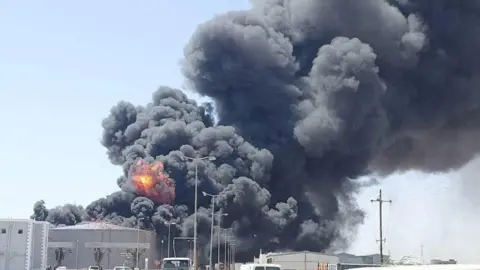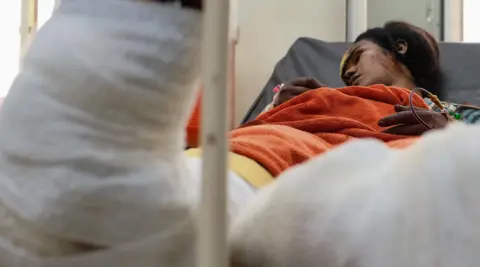BBC News
 Reuters
ReutersParamilitary fighters appear to have opened a new phase in Sudan’s civil war after being driven from the capital, in a move which some experts have described as a “shock and awe campaign”.
Just weeks after the army celebrated the recapture of Khartoum, its foe the Rapid Support Forces (RSF) launched a series of unprecedented drone strikes on Port Sudan in the east of the country.
The attacks have led to worsening power blackouts, as well as city residents facing water shortages.
“It’s a level of power projection within this region that we haven’t seen yet,” says Alan Boswell, the Horn of Africa expert for the International Crisis Group.
“I think it raises the stakes quite a bit,” he added.
The barrage of attacks on the war-time capital and humanitarian hub signals that the RSF is determined and able to carry on the fight despite significant territorial losses.
And it has showcased the growth of advanced drone warfare in Africa.
Drones have played an increasing role in the conflict, which has entered its third year.
The war began as a power struggle between the Sudanese Armed Forces (SAF) and the RSF and has drawn in other Sudanese armed groups and foreign backers, plunging the country into what the UN calls the world’s worst humanitarian crisis.
Unmanned aerial vehicles (UAVs) helped the army advance earlier this year. And the RSF escalated its own use of drones as it was pushed out of central Sudan, especially Khartoum, back towards its traditional stronghold in the west of the country.
In recent months the paramilitaries had stepped up drone strikes on critical civilian infrastructure in army-controlled areas, such as dams and power stations.
But their sustained attacks on Port Sudan, until now seen as a safe haven home to government officials, diplomats and humanitarian organisations, underlined a shift in strategy to a greater emphasis on remote warfare, and aimed to demonstrate strength.
 Reuters
Reuters“The RSF is trying to show that they don’t need to reach Port Sudan by land in order to be able to have an impact there,” says Sudanese political analyst Kholood Khair.
The group is trying to achieve a “narrative shift” away from “the triumphant SAF that took over Khartoum,” she says.
“It is saying to the Sudanese Armed Forces: ‘You can take Khartoum back, but you’ll never be able to govern it. You can have Port Sudan, but you won’t be able to govern it, because we will cause a security crisis for you so large that it will be ungovernable’… They want to unequivocally show that the war is not over until they say so.”
The paramilitary group has not directly addressed the Port Sudan drone attacks. Rather, it has repeated its assertion that the SAF is supported by Iran and accused the armed forces of targeting civilian infrastructure and state institutions, calling the military strikes on Khartoum and RSF-held areas in the west and south of the country war crimes.
Both sides stand accused of war crimes which they have denied, but the RSF has been singled out over allegations of mass rape and genocide.
The change in its tactics may have been triggered by battlefield necessity, but is possible because of technological advancement.
The RSF had previously used what are known as suicide or loitering drones, small UAVs with explosive payloads that are designed to crash into targets and can carry out coordinated attacks.
It seems to have deployed this method in Port Sudan, with the commander of the Red Sea Military Zone Mahjoub Bushra describing a swarm of 11 Kamikaze drones in the first strike on a military airbase.
He said the army shot them down, but they turned out to be a tactical distraction to divert attention from a single strategic drone that successfully struck the base.
The make of this drone is not clear. But satellite images reported by Yale researchers and the Reuters news agency have shown advanced UAVs at an airport in South Darfur since the beginning of the year.
The defence intelligence company Janes has determined them to most likely be sophisticated Chinese manufactured CH-95s, capable of long-range strikes.
Jeremy Binnie, an Africa and Middle East analyst at Jane’s, told the BBC that photos of what appear to be the remnants of the smaller kamikaze drones suggest they are probably a different version than the RSF had used before, and might be better at penetrating air defences because of their shape.
 Reuters
ReutersOne regional observer suggested the RSF had been able to breach the SAF’s anti-drone technology with signal jammers attached to the drones, but cautioned this was still unproven.
The South Darfur airport in Nyala, the presumptive capital and military base of the Rapid Support Forces, has been repeatedly bombed by the SAF, which destroyed an aircraft there earlier this month.
Some experts see the RSF’s bombardment of Port Sudan at least partly as retaliation.
The escalating drone warfare has again highlighted the role of foreign actors in Sudan’s civil conflict.
“This is a war of technology,” says Justin Lynch, managing director at Conflict Insights Group, a data analytics and research organisation.
“That’s why the foreign supporters are so important, because it’s not like the RSF is making the weapons themselves. They’re being given this stuff.”
The army has accused the United Arab Emirates (UAE) of supplying the paramilitary fighters with the drones, and cut diplomatic ties with Abu Dhabi because of the attacks.
The UAE has strongly rejected the charges. It has long denied reports from UN experts, US politicians and international organisations that it is providing weaponry to the RSF.
But Mr Lynch says the evidence is overwhelming.
He was the lead author of a US State Department-funded report late last year that concluded with “near certainty” the the UAE was facilitating weapons to the RSF by monitoring imagery and flight patterns of airlines previously implicated in violating a UN arms embargo.
He told the BBC it would be surprising if the Emiratis were not helping deliver the drones used in the Port Sudan attacks.
He also determined with similar near-certainty that the Iranians were supplying weapons to the SAF, and he helped authenticate documents provided to the Washington Post that detail the sale of drones and warheads to the army by a Turkish defence firm.
Iran has not responded to the allegations. Turkish officials have denied involvement.
The increasing use of drones by both sides may be redefining the war, but it is the ability of the RSF to strike strategic targets hundreds of kilometres from its positions that has rattled the region.
Over a week of daily attacks on Port Sudan, the paramilitaries hit the country’s only working international airport, a power station, several fuel depots, and the air base, apparently trying to disrupt the army’s supply lines.
The city is also the main entry port for relief supplies and the UN has warned that this “major escalation” could further complicate aid operations in the country and lead to large-scale civilian casualties.
“This was such a shock and awe campaign that it has not only stunned SAF, I think it’s also stunned Egypt, Saudi Arabia, others who were behind SAF, and remakes the entire war,” says Mr Boswell, adding that it closing the gap in air power between the RSF and the army.
“The RSF is widely viewed as a non-state actor,” he says “and normally, groups like that can muster quite a bit of an insurgent force. But the government with the air force is the one that always has the aerial capacity, and this just turns all those old adages on its head.”

The development has triggered comparisons to the long-range drone warfare between Russia and Ukraine.
“These weapons have more precision, you don’t need a manned aircraft any more, and they are much more affordable than operating sophisticated jets,” says Mr Binnie.
“This is part of a broader trend in technological proliferation where you can see what used to be really high-end capabilities being used in a civil war in sub-Saharan Africa.”
The Sudanese foreign ministry has warned that the attacks threaten regional security and the safety of navigation in the Red Sea, calling on international actors to take “effective action against the regional sponsor of the militia,” a reference to the UAE.
Mr Lynch believes that only an agreement between the UAE and the Sudanese army will end the war.
“This war is always evolving, always changing,” he says, “but you’ll see it will continue for years and decades unless there is serious diplomatic action to stop it.”
More about Sudan’s civil war from the BBC:
 Getty Images/BBC
Getty Images/BBC
